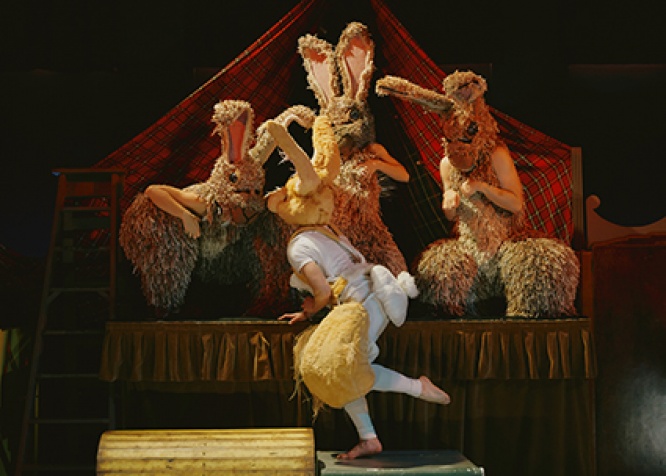
Here's a question: Is being in touch with your inner child - a pop psychology-related term for a person's supposed original or true self, the being inside you associated with innocence, creativity, excitement and undiluted emotion - a desirable prerequisite for watching live performances made for children and family audiences?
Well, to my mind it can't hurt. Regardless of the capacity in which an adult views a production created for an all-ages public - whether that means accompanying young people to the theatre or, in my case, being a member of the arts industry - a good guiding principle is to go with an open mind and a child-like sensibility.
I've been thinking about the lately because of a trio of shows I saw in London during the recent Easter break. Each was a treat, but for distinctly different reasons.
Pitched at 3-5 year-olds (and autistic/neurodivergent children ages 3-7), Second Hand Dance's The Sticky Dance was a lively yet relaxed, gently interactive, sensory and wordless performance in which the audience occupied a performance space with, to quote the flyer, three dancers 'weaving a tapestry of sticky tape.'
Four Seasons, by the theatre company Little Bulb, was a quick-paced, highly verbal and Vivaldi-laced frolic through a calendar year. Led by a cast of three, it featured a consistently ingenious, DIY-style use of props, sets and costumes.
And finally there is balletLORENT's The Velveteen Rabbit, in some respects the most traditional and grandest of these shows particularly given its production values and staging. Having said that, it has the feel of an intimate, cosy piece - the performance equivalent of being wrapped in a warm blanket, or given a cuddle while someone tells you a story.
Subtitled 'or how toys become real, director and choreographer Liv Lorent's artful, lovingly crafted and narrative-driven dance work is based upon a book by Margery Williams first published just over 100 years ago. Williams' classic tale, re-told here and narrated in a dulcet voiceover by Ben Crompton, concerns a young boy whose most cherished toy - more like a companion, really - is a stuffed bunny. In this version the boy is now a man returned to his childhood home for a clearing out. In the process he recalls, and effectively relives, a charmed and playful past that never really left him.
Designed by Nasir Mazhar, the show's colourful, impressive set is a veritable warren of trunks, doors, trapdoors, drawers, wheeled tables and building blocks on two levels: a clear 'ground floor' space and a smaller, more theatrical upper platform. Think playroom crossed with attic. Mazhar's costumes are just as - or maybe even more - beguiling and variously textured. Highlights include a silver-cube robot, a mechanical monkey, a shaggy dog and a trio of wild rabbits with wonderfully big, shakeably furry haunches. Spoiler alert: there's also a climactic, deus ex machina-style cameo for a completely glittering nursery fairy whose eye-catching appearance and twirling movement carries an almost ecstatic charge of pleasure.
But there are more than surface satisfactions here. Lorent and her creative team - including creative partners Geoff Hopson and Debbi Purtill; longtime music collaborator Murray Gold and budding composer Albie Crompton' plus another company 'regular,' the lighting designer Malcolm Rippeth - apply their skills to a deceptively simple scenario chock-full of underlying and resonant themes. Without getting heavy about it, among them are the power of imagination, the need for affection, acceptance and community, the inevitability of loss and the value of letting go.
Credit, too, to a cast of six led by the ever-nimble, innately boyish Gavin Coward and Natalie MacGillivray's uncloyingly sweet embodiment (abetted by Emmy Crompton's selective vocal delivery) of the title role. Toby Fitzgibbons, Berta Admettla, Montaine Ponceau and Virginia Scudeletti (the latter in, as already noted, the outstanding fairy guise) also serve the show well. Lorent, for her part, gives them plenty to do. Lasting 45 minutes in the extended, family version I saw (as opposed to an under-3's take that is ten minutes less), the performance never flags. Physically active, absorbing and affecting, it pretty much does it all for us.
That's one of the qualities which distinguishes The Velveteen Rabbit from the other two and equally worthwhile productions mentioned above. Some performances invite you in while others reach out to you. What conclusion can be drawn from this? That although the methods of making work for young people and familes may vary, there's ample room for all aesthetic approaches. The bottom line is to appeal to a full spectrum of inner children no matter what their actual ages.
Donald Hutera is a veteran freelance arts journalist whose current outlets include The Times and The Stage. He is also a devising performer and member of Rhiannon Faith Company and Posh Club*Dance Club.